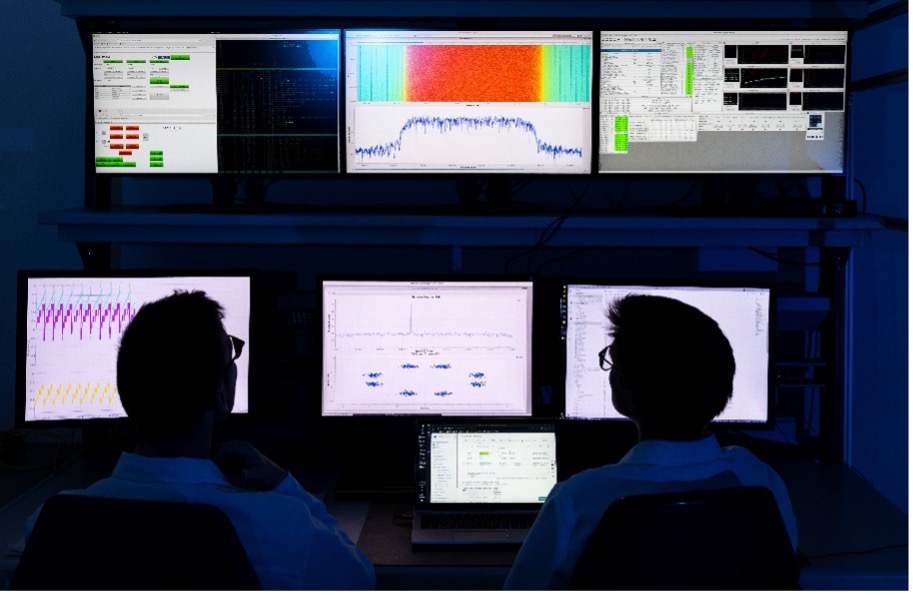Contact Press / Media
Rainer Wansch
Head of RF and SatCom Systems Department
Fraunhofer IIS
Am Wolfsmantel 33
91058 Erlangen, Germany
When flash flooding hit Germany’s Ahr Valley in July 2021, communication suddenly came to a standstill. Base stations were damaged, cables were severed, antennas were washed away, wireless networks collapsed, and dead zones appeared – and in these days of devastation, mobile communication companies were not the only ones asking themselves how our society’s communication infrastructure could be better protected in the future.
Almost exactly two years since the floods, the Heinrich Hertz mission of the German Space Agency at the German Aerospace Center (Deutsches Zentrum für Luft- und Raumfahrt; DLR) is now underway. After years of hard work, Germany has once again succeeded in sending a communication satellite of its own into space. The mission is intended to lead satellite communications into the future – and, to support the mission’s success, we developed one of the key elements of the Heinrich Hertz satellite: the Fraunhofer On-Board Processor (FOBP).
We can think of conventional communication satellites as messengers that relay messages with no knowledge of their content. Signals are simply received from one ground station and relayed to the next. With the FOBP, however, we’ve developed a powerful and regenerative payload that sits on board the satellite and processes signals digitally. Now, the messenger no longer simply delivers messages but also casts a watchful eye over them, correcting any errors it spots and considering which information to prioritize. It also instructs other messengers that are closer to the destination. In short, FOBP makes the satellite itself more intelligent.
Here, another key feature is the ability to reconfigure the On-Board Processor. Like a smartphone installing updates to meet new demands, we can not only control the FOBP from the ground at an altitude of 36,000 kilometers using our multiband satellite antenna but we can also reprogram it by uploading configuration files and therefore adapt it to new communication standards at any time.
The FOBP’s ability to adapt to wide-ranging applications provides industry with a solution to a dilemma that arises whenever an innovation in satellite communications sees the light of day. Namely, the new technology can only be sent into space if it can demonstrate that its functionality is impervious to radiation and extreme temperature variations. To prove this, however, the technology first requires access to space.
The FOBP helps to resolve this paradox by converting itself into a laboratory in Earth’s orbit. In collaboration with us, companies and research institutes can use this laboratory to demonstrate that their technologies are at once innovative and tried-and-tested by conducting communication experiments in real-world conditions. They can begin by preparing these technologies for use in space on a twin of the FOBP in our in-house thermal vacuum chamber. A virtual TM/TC link is then used to implement the technology in the actual FOBP as it orbits Earth.
These over-the-air tests can encompass the entire transmission chain of satellite communications. For example, one application scenario relates to components that are used directly in a satellite. Companies that develop their own on-board processors can test subcomponents for their suitability for space. Likewise, the FOBP can be used to optimize technologies that organize frictionless communication from the ground. These technologies include modems whose functionalities are adapted to different waveforms, as well as antennas with enhanced performance profiles so that they operate effectively even in storms and rain. Moreover, the industry is exploring different approaches such as beam hopping with a view to significantly increasing capacity. Here, "dress rehearsals" in space help to determine the potential – and limits – of the individual concepts.

We also want to explore the future of satellite communications through our own experiments. For example, how can the FOBP help to improve the protection of our society’s communication infrastructure in the future? With this in mind, we are planning a project to simulate and practice large-scale emergencies. For instance, if flooding such as that seen in the Ahr Valley happens again and knocks out mobile communications, the emergency services in particular will need data traffic to keep flowing even without a base station. Here, the flexibility of the FOBP means that it can provide stable and reliable direct connections to the satellite, thereby acting in space as an extended arc of protection over communication here on Earth.

The mission of the Heinrich Hertz satellite has been underway since July 2023 – and, given that one of the key elements is the Fraunhofer On-Board Processor (FOBP), we are right in the midst of the action. This processor can be reprogrammed from Earth at any time and transforms into a laboratory that the satellite and communication industry can use to test their own technologies in space.